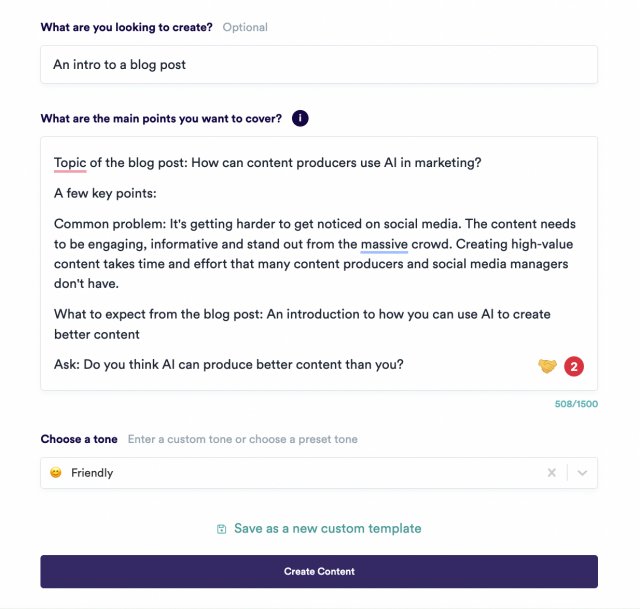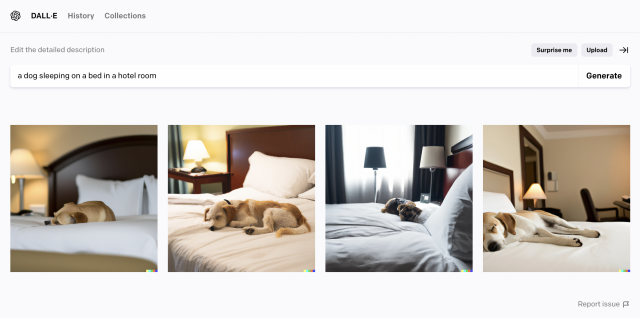How content producers can use AI in digital marketing

Do you want to use AI to create better content? There’s no doubt that content production is getting more complex every day. It’s getting hard to get noticed on social media. Your inbox is packed with repetitive messages, and you must fight against a massive crowd to get people to read your content. And then there’s the problem of creating high-value content—it takes time and effort that many content producers and social media managers don’t have. Wouldn’t it be great if AI could help you?
Yes, it would! Today I’ll dive into how AI can produce better content for you than any human could ever do.

Fun fact – The text above was created for me in under 2 minutes using Copy.AI. All I had to do was explain what I wanted to write and what information the introduction should contain.
Original text:
Topic of the blog post: How can content producers use AI in marketing?
A few key points:
Common problem: It’s getting harder to get noticed on social media. The content needs to be engaging, informative and stand out from the massive crowd. Creating high-value content takes time and effort that many content producers and social. media managers don’t have.
What to expect from the blog post: An introduction to how you can use AI to create better content.
Ask: Do you think AI can produce better content than you?
Impressive, right?
But what is AI?
Artificial intelligence can be used by businesses to, for example, inform customers about their products, provide personalized alternatives, and understand their customers better.¹ Businesses and content creators also use Ai when creating content for campaigns and digital marketing, such as copywriting (copy.ai), graphic design (graphicdesign.ai) and even photography (dall-e 2).
And why is high-value content important?
Creating content is time-consuming but necessary to maintain connections online. A study by Kenzie Burchell² shows that social media users feel disconnected from people who use the same social media platform but for different reasons than themselves. And a study by Stina Bengtsson and Sofia Johansson³ shows that young social media users in Sweden “unfollow” other social media users to whom they don’t feel connected. They “unfollow” users that they are not inspired by, and users make them feel “the wrong thing”.
A study by Nicolas Hamelin, Sameh Ai-Shihabi, Sara Quach and Park Thaichon in 2022⁴ showed that the company logo and brand name aren’t as important as the photographs and information used in advertisements. According to the study, we can assume that it is more important now than ever to create high-value content offline and online. With 96% of 20 to 30-year-old Swedes using social media daily³, this is also very important online. Businesses should focus on creating lively entertainment to strengthen their relationships on social media. ⁵ By using pictures and text to evoke emotions, you affect how your customers receive your content. How successful you are in evoking emotions in your customers can be measured with, for example, likes and engagement rates.
It’s time to embrace AI
– Nobert Wirth
How can you use AI in content creation?
Artificial Intelligence can help digital marketers achieve big things. ⁶ New AI applications are appearing on the market constantly. An AI application should be able to learn, reason, predict and plan. With this, you can use AI to create better content, for example, text production, image editing⁷ and video production. AI solutions are already replacing human knowledge in online targeting and dynamic attribution. ⁷
Here are four different ways you can use AI to create better content:
-
Copywriting.
- AI can be used to create simple text but also more complicated ones. You can use AI to write text for your Instagram och blog post, create content for your website and even write difficult e-mails.
- AI can be used to create simple text but also more complicated ones. You can use AI to write text for your Instagram och blog post, create content for your website and even write difficult e-mails.
-
Proofread your content
- You can also use AI to proofread the content that you have created. Having AI proofread your text is an easy and fast way to check your grammar and even get suggestions on making your text easier to read. Another fun fact; this text was proofread by Grammarly, which helped me make the text easier to read = better SEO points, YEY!
-
Edit your photos
You can use AI to get beautiful and professional-looking results quickly. Some apps can edit the light and colours and even delete unwanted things from the photo. Using Dall-e 2 you can create an image from scratch without leaving your home.

-
Edit videos
You can use AI to create new videos and edit your own. Ai can, for example, be used to match the colours of your video clips and cut your video clips so that the transitions are smoother. And just like photos, Ai can create new videos from scratch (more on the negative aspects of this later).
So… Should you use it?
Social media can negatively impact entrepreneurs⁸ and social media and marketing managers. Social media is becoming a big part of our lives, and social media connections require more time and attention than ever before⁸. A study on by Fakhar Shahzad, Adnan Fateh, Raja Suzana, Raja Kasim, Kashif Akram & Sheikh Farhan Ashraf showed that entrepreneurs with many social media followers are spending more and more time maintaining their connections. According to the study, female entrepreneurs feel stressed when they cannot keep their social media at the required level. Also, a study by Faseeh Amin and Mohammad Furqan Khan⁹ shows that people who are concerned about their number of likes and followers on social media are more stressed due to social media. It also shows that people who are dependent on social media platforms are more likely to feel stressed than others.
From the studies mentioned above, we can conclude that social media managers and marketers feel stressed when they have less time to create content and maintain relationships with their customers on social media. By using AI to help you write engaging Instagram captions and create eye-catching graphics, you’ll have more time to engage with your followers, build relationships and drive traffic to your social media accounts. And since social media platforms work best when used as a tool to communicate with your customers¹⁰, you should use more time to engage and communicate instead of just creating the content.
What can be the negative impacts of AI-produced content?
Remembering the negative impacts AI can have on content production is crucial. You can even create fake videos and photos of people doing things that they haven’t done¹ which, in my opinion, isn’t ethical at all. It can be challenging to notice if an AI-made video is fake, and it can be very dangerous. Fake videos made by AI are used in, for example, political campaigns.
Leave your opinion in the comments!
In my opinion, AI applications like Grammarly, Copy.Ai, and Adobe Sensei are great additions to a content producer’s toolbox. In my experience, content production can be highly time-consuming. Creating engaging content for over five social media accounts daily can be challenging. Having the chance to use AI to create better content is always welcome. With that said, it is essential to use them ethically. For example, I don’t think creating false pictures of a destination or business is ethical. My question is… If you use AI when creating content, does it mean that the content is no longer yours, or are these just more tools for the content producer’s toolbox to make even better content?
So what do you think? Is AI something you consider using when creating content for your next marketing campaign?
Sources:
¹ Patrick Van Esch and J. Stewart Black (2021), Artificial Intelligence (AI): Revolutionizing Digital Marketing
² Kenzie Burchell (2017), Everyday communication management and perceptions of use: How media users limit and shape their social world
³Stina Bengtsson and Sofia Johansson (2022), The Meanings of Social Media Use in Everyday Life: Filling Empty Slots, Everyday Transformations, and Mood Management
⁴Nicolas Hamelin, Sameh Al-Shihabi, Sara Quach and Park Thaichon (2022), Forecasting Advertisement Effectiveness: Neuroscience and Data Envelopment Analysis
⁵Xi Chen, Chunlan Jiao, Ran Ji and You Li (2021), Examining Customer Motivation and Its Impact on Customer Engagement Behavior in Social Media: The Mediating Effect of Brand Experience
⁶Mithun S. Ullal, Iqbal Thonse Hawaldar, Rashmi Soni and Mohammed Nadeem (2021), The Role of Machine Learning in Digital Marketing
⁷Nobert Wirth (2018), Hello marketing, what can artificial intelligence help you with?
⁸Fakhar Shahzad, Adnan Fateh, Raja Suzana Kasim, Kashif Akram and Sheikh Farhan Ashraf (2021), Late-Night Use of Social Media and Cognitive Engagement of Female Entrepreneurs: A Stressor–Strain–Outcome Perspective
⁹Faseeh Amin and Mohammad Furqan Khan (2020), Online Reputation and Stress: Discovering the Dark Side of Social Media
¹⁰Amir Zaib Abbasi, Raouf Ahmad Rather, Ding Hooi Ting, Saima Nasir, Khalil Hussain, Muddasar Ghani Khwaja and Amjad Shamin (2022), Exploring tourism-generated social media communication, brand equity, satisfaction, and loyalty: A PLS-SEM-based multi-sequential approach
- How content producers can use AI in digital marketing - December 20, 2022